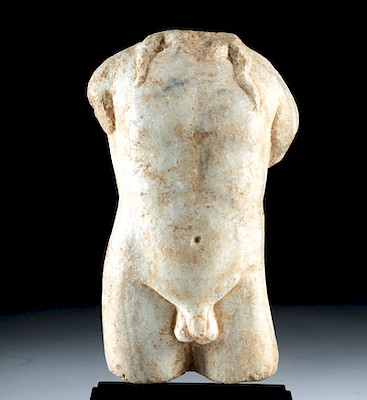Early Tell Halaf Terracotta Mother Goddess
Lot 62
About Seller
Artemis Gallery
686 S Taylor Ave, Ste 106
Louisville, CO 80027
United States
Selling antiquities, ancient and ethnographic art online since 1993, Artemis Gallery specializes in Classical Antiquities (Egyptian, Greek, Roman, Near Eastern), Asian, Pre-Columbian, African / Tribal / Oceanographic art. Our extensive inventory includes pottery, stone, metal, wood, glass and textil...Read more
Estimate:
$1,200 - $1,800
Absentee vs Live bid
Two ways to bid:
- Leave a max absentee bid and the platform will bid on your behalf up to your maximum bid during the live auction.
- Bid live during the auction and your bids will be submitted real-time to the auctioneer.
Bid Increments
| Price | Bid Increment |
|---|---|
| $0 | $25 |
| $300 | $50 |
| $1,000 | $100 |
| $2,000 | $250 |
| $5,000 | $500 |
| $10,000 | $1,000 |
| $20,000 | $2,500 |
| $50,000 | $5,000 |
| $100,000 | $10,000 |
| $200,000 | $20,000 |
About Auction
By Artemis Gallery
Dec 5, 2018
Set Reminder
2018-12-05 10:00:00
2018-12-05 10:00:00
America/New_York
Bidsquare
Bidsquare : DAY 1 | Classical Antiquities & Asian Art
https://www.bidsquare.com/auctions/artemis-gallery/day-1-classical-antiquities-asian-art-3698
Day 1 of an important 2-day auction featuring ancient and ethnographic art from around the world. Egyptian, Greek, Roman, Viking, Near Eastern plus Asian Art from China, Japan, Thailand, Vietnam, Burma, India, more. Artemis Gallery info@artemisgallery.com
Day 1 of an important 2-day auction featuring ancient and ethnographic art from around the world. Egyptian, Greek, Roman, Viking, Near Eastern plus Asian Art from China, Japan, Thailand, Vietnam, Burma, India, more. Artemis Gallery info@artemisgallery.com
- Lot Description
Ancient Near East, Anatolia (central Turkey) or northern Syria, Tell Halaf area, ca. 6500 to 4500 BCE. A rather large terracotta fertility figure depicting a seated woman with voluptuous breasts and thighs that emphasize her fruitfulness. Dark pigment striations adorn her chest, waist, and legs, and vibrant painted details remain on her face. The mother goddess was modeled in clay, dried in the sun, and then painted with patterns that may represent tattoos or jewelry. An exquisite and remarkably early example from ancient Anatolia! Custom wooden display stand included. Size: 1.625" W x 4.2" H (4.1 cm x 10.7 cm); 5" H (12.7 cm) on included custom stand.
As early as the 7th millennium BCE, cultures in the Near East began creating organized settlements with highly-developed religious as well as funerary practices. The Halaf culture of Anatolia (central Turkey) and northern Syria produced mesmerizing female figurines with fertility attributes. Whether images like these were intended to represent real, ideal, or divine women is unknown; however, scholars believe that their primary purpose was to encourage female fertility.
Provenance: private Southern California, USA collection, acquired in the 1970s to mid-1980s
All items legal to buy/sell under U.S. Statute covering cultural patrimony Code 2600, CHAPTER 14, and are guaranteed to be as described or your money back.
A Certificate of Authenticity will accompany all winning bids.
We ship worldwide and handle all shipping in-house for your convenience.
#140881Light fading to applied pigmentation, small nicks to feet and head, and heavy white encrustations across most surfaces, otherwise intact and excellent. Nice earthen deposits and traces of pigmentation throughout.Condition
- Shipping Info
-
All shipping is handled in-house for your convenience. Your invoice from Artemis Gallery will include shipping calculation instructions. If in doubt, please inquire BEFORE bidding for estimated shipping costs for individual items.
-
- Buyer's Premium



 EUR
EUR CAD
CAD AUD
AUD GBP
GBP MXN
MXN HKD
HKD CNY
CNY MYR
MYR SEK
SEK SGD
SGD CHF
CHF THB
THB














